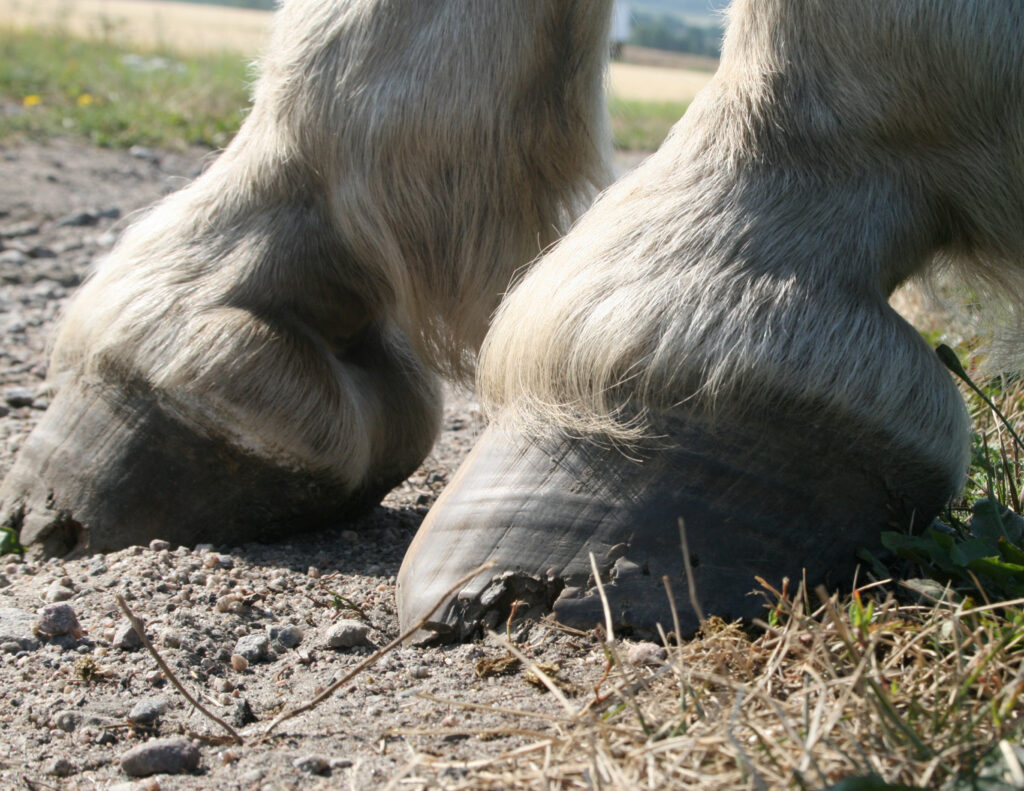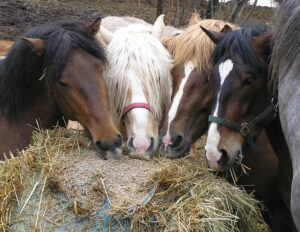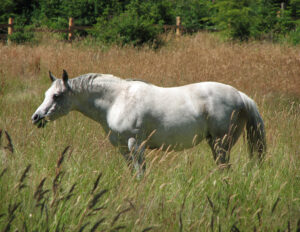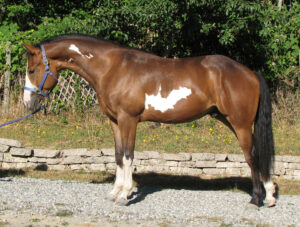
Many hoof problems, including crumbling walls and white line disease, can be at least in part related to diet, so if all else is in order, changing the diet may be the missing piece of the puzzle. Photo courtesy of The Essential Hoof Book.
Excerpt from The Essential Hoof Book
A critically important component of hoof health for horses of any age is diet. In fact, diet is so often at the root of a horse’s hoof problems that it should be one of the very first avenues of inquiry with any horse that has non-injury related issues with its feet. In addition to laminitis, issues such as tenderfootedness, flat soles, shelly walls, white line disease, flaring, and many, many other common hoof problems can all be related to what the horse is eating, and solving these issues almost always goes more easily if the dietary concerns are addressed.
Usually, making the horse’s diet more foot friendly ends up being a matter of “less is more”. Ask any vet or equine nutritionist and they will tell you that far more problems – hoof and otherwise – are caused by overfeeding horses than by underfeeding them. It may make us feel good to put our horses out on lush pasture, feed them rich hay, top them up with grain, stuff them with carrots and apples, and pile on the supplements designed to improve hoof quality, but all of these things have the potential to be extremely detrimental to our horses’ hooves and overall health.
Providing a diet that promotes hoof health should be an absolute must for all horse owners, but if you have a horse with a known metabolic disorder or hoof issues that even hint of laminitis (remember the subtle signs!), controlling the horse’s diet can make the difference between soundness and a life of problems, pain and debilitation. Countless horses endure prolonged suffering simply because their owners have not been made aware that what they are feeding is a major factor in their horse’s foot problems, or they have been made aware but are not taking this issue seriously enough.
When it comes to feeding and hoof health, what we really need to be looking at, in most instances, is how to keep things out of the horse’s diet that weaken the hoof – specifically, too many simple sugars and starches, what we might call “quick” carbohydrates. There is a mounting body of evidence that sugars and starches that convert quickly into glucose in the body result in damage to the laminae, which as we’ve seen can have all sorts of consequences, some of which can be devastating.
Obvious sources of quick carbs are grains and anything sugary or coated with molasses. Less obvious and often overlooked sources are hays high in ESCs (ethanol soluble carbohydrates) or starch, and pasture with elevated levels of sugar due to seasonal changes or stresses such as overgrazing, frost, or drought. Non-native or “improved” grasses – varieties of grass designed to put weight on cattle – can also be problematic, as can those beloved carrots and apples for some horses (fig 14.12). In addition, some horses react to high protein diets the same way they would to a high carb diet, so care should be taken when feeding high protein feeds or hay containing alfalfa.

Many people consider grain-based feeds a staple for their horses’ diets, but horses are not designed to handle large amounts of grain. In many cases, long-standing hoof problems will finally resolve once the horse is taken off grain and other sources of quick carbs. Photo courtesy of “The Essential Hoof Book”
Any horse that is known to be prone to laminitis or exhibits any of the subtle signs that can indicate subclinical laminitis, as well as horses that gain weight easily or have been identified as having metabolic problems, should be put on a strict, low-carb diet free of all grain and grain products, sugary substances, apples and carrots (both of which contain a surprising amount of sugar), and anything else that might load them with simple sugars or starch, including fresh grass, which is always a risk for carb-sensitive horses. The ideal diet for such horses will consist mainly of low-carb, moderate protein hay that has been analyzed, as there is truly no way to know the nutrient profile of any hay that has not been tested.
A diet lower in simple sugars and starches may actually be beneficial to all horses, as we now understand that the equine digestive system is not set up to handle sugary or starchy feeds in significant amounts. Diets too high in these substances are known to be a major factor in the formation of gastric and hind gut ulcers in horses, an extremely common health problem that often goes unrecognized. All of this doesn’t mean that you should necessarily cut out all grain, grass, and sweet treats from every horse’s diet, but it does mean that you should be careful and observant when using such feeds, and make sure that your horse is not showing any symptoms of laminitis, ulcers, weak/thin walls, or obesity – another very common problem in the horse world today.
And, if you think those extra pounds are really no big deal, think again. The feet of a horse that is overweight are subject to both metabolic and mechanical stresses, making them much more prone to problems. One study by researchers at Virginia Tech found that overweight horses are vulnerable to chronic inflammation, oxidative stress, insulin/glucose imbalances, heat stress, reduced performance levels, and increased bone, tendon and joint injuries (fig 14.13). They concluded that obesity is a major health concern in horses that has been widely under-reported.

Although you might think this obese horse is happy with all that grass, her feet and body are experiencing both metabolic and mechanical stresses. Photo courtesy of
“The Essential Hoof Book”
Unfortunately, many of us have horses that are overweight and we don’t even know it, due to widespread misconceptions as to what constitutes a healthy weight. Equine nutritionists generally say that you should be able to see a hint of ribs on a horse until it is two or so, and after that, you want to be able to easily feel, but not see their ribs. It is also useful to get familiar with the Henneke scale, a rating system for equine body condition that uses specific markers to determine where a horse falls on a scale of 1 to 9, with one being emaciated and 9 being extremely obese. The ideal body condition for most horses is around 5 on the Henneke scale. Ultimately, it is each owner’s responsibility to educate themselves on what is a healthy weight for their horse and to monitor their horse’s body condition.
A good diet for most horses – average to easy keepers – will be forage based and will consist mainly of hay that is moderate in simple sugars and protein, with a balanced vitamin/mineral supplement as needed, access to salt, and little if any grain. Hard keepers or hard-working horses may need more calories in their diet than grass hay can provide, but many equine nutritionists are now recommending the addition of calories in the form of fats, such as vegetable oils or rice bran, instead of loading the horse up on starches and sugars. Fats are easily digested and utilized by the horse, whereas sugars and starches can not only damage the feet, but can also wreak havoc with the digestive system.

This horse would rate right around five on the Henneke scale, which is just where you want a horse to be. Photo courtesy “The Essential Hoof Book”
Did you enjoy this article? Leave us a comment below, and get more great hoof information in The Essential Hoof Book! And, if you would like to get notified of new articles posted here on The Essential Horse, be sure to click “subscribe” on the bottom left of this page!